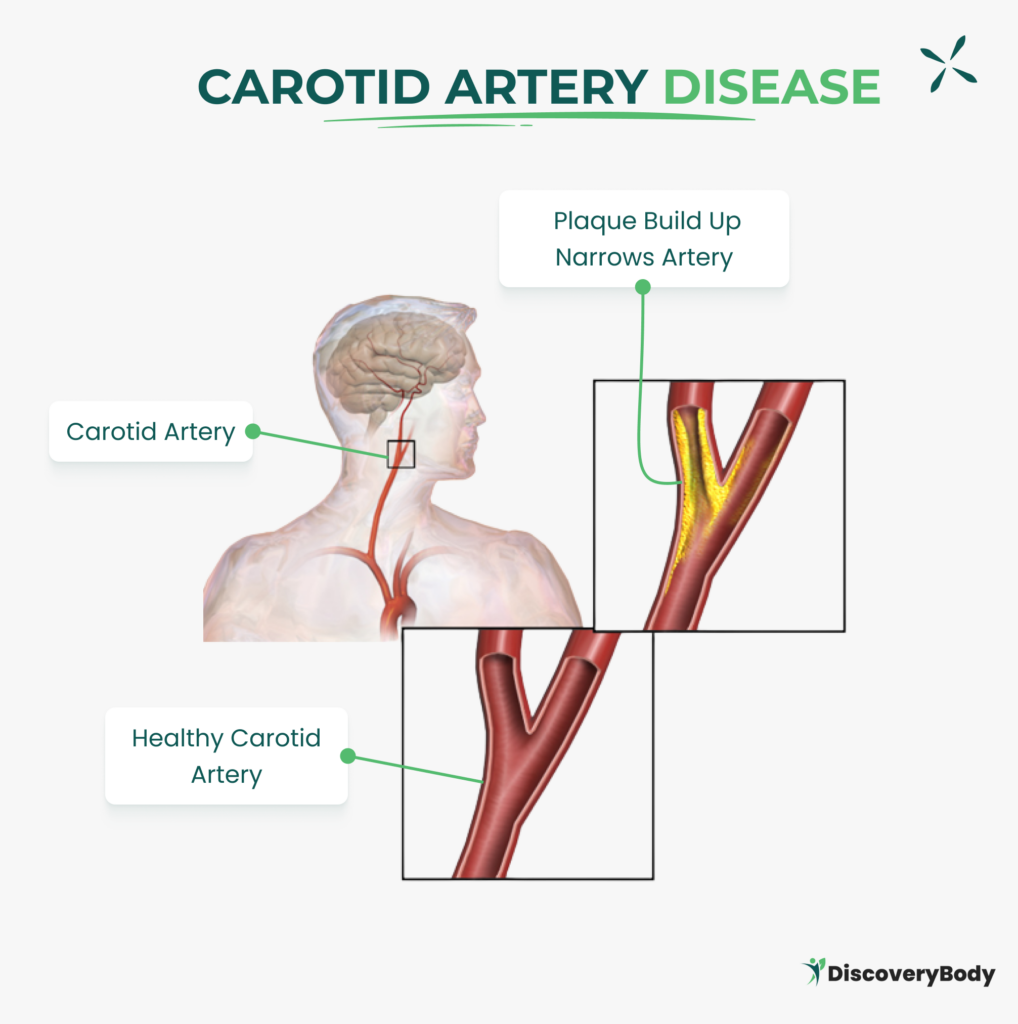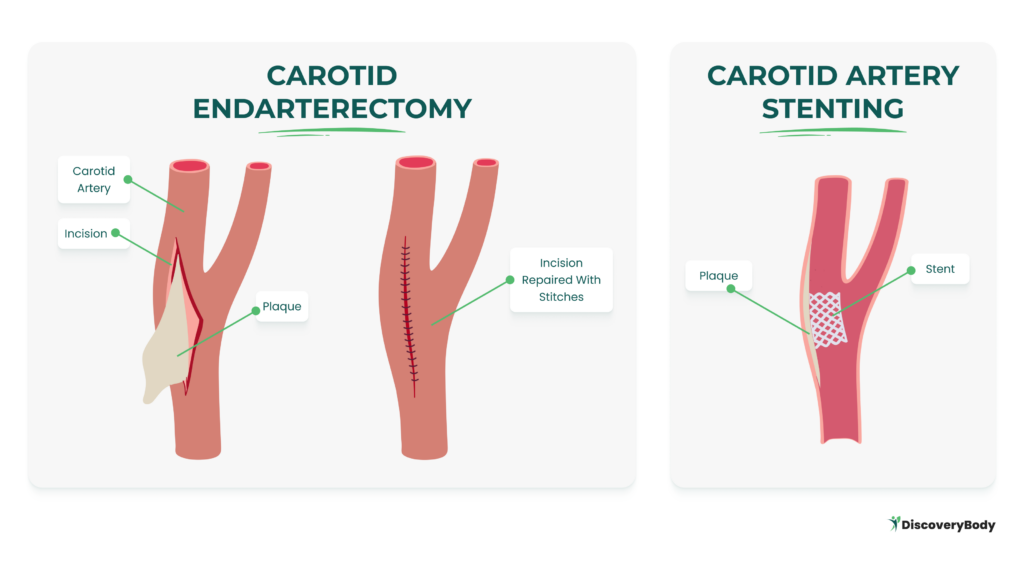No products in the cart.
Medically Accredited
What are the Symptoms of Blocked Arteries in Your Neck: Recognizing the Warning Signs
Are you aware of the importance of your carotid arteries? These vital blood vessels, situated on either side of your neck, deliver blood to your brain. However, when blockages occur in these arteries, it can lead to a condition known as carotid artery disease, also known as carotid artery stenosis, which significantly increases the risk of stroke. In this guide, we will explore the symptoms of blocked arteries in your neck, helping you to recognize the warning signs and take relevant steps to treat or prevent the onset of this condition.
What’s the Disease that Blocks the Arteries in your Neck?
The carotid arteries are located on each side of the neck and are responsible for supplying blood to the brain. When these arteries become narrowed or blocked due to atherosclerosis, it can result in carotid artery disease (blocked arteries in your neck).

Atherosclerosis is a progressive disease that involves the accumulation of cholesterol, fat, cellular waste, protein, and calcium in the arteries. Over time, this buildup restricts blood flow and reduces the flexibility of the carotid arteries, leading to several health complications.
Carotid artery disease is a significant cause of strokes, which occur when blood flow to the brain is interrupted. According to the Centers for Disease Control and Prevention (CDC), more than 795,000 people have a stroke every year in the United States alone. One third of all strokes are related to carotid disease as presented in a study from StatPearls.
What are the Risk Factors for Blocked Arteries in your Neck?
Aside from atherosclerosis, certain risk factors contribute to the development of carotid artery disease. Understanding these risk factors can help you assess your own risk and take relevant steps to prevent the onset of this condition. Some common risk factors include:
- High blood pressure: Uncontrolled high blood pressure puts strain on the arteries, making them more susceptible to damage and plaque buildup. Managing blood pressure levels is important for reducing the risk of carotid artery disease.
- High cholesterol: Excess cholesterol in the bloodstream is a major risk factor for atherosclerosis.
- Diabetes: Diabetes increases the risk of developing carotid artery disease as high blood sugar levels can damage the blood vessels, accelerating the accumulation of plaque.
- Obesity: Being overweight or obese puts additional stress on the cardiovascular system, increasing the risk of plaque buildup in the carotid arteries.
- Physical inactivity: Leading a sedentary lifestyle contributes to high blood pressure, diabetes, and obesity.
- Smoking: Smoking irritates the inner lining of the arteries, leading to inflammation and increased heart rate and blood pressure.
- Age: As we grow older, our arteries become stiffer and more prone to damage.
- Gender: Males are more at risk of developing carotid artery disease than females.
- Family history: Having a family history of atherosclerosis increases the likelihood of developing carotid artery disease.
- Neck Trauma: Previous neck trauma, such as a car accident or injury, can damage the carotid arteries, making them more susceptible to blockage.
It’s important to note that these risk factors can be managed or modified through lifestyle changes or medical intervention. By addressing these factors, you can reduce your risk of carotid artery blockage and related complications.
What Are the Symptoms of Blocked Arteries in Your Neck?
Early-stage carotid artery disease usually presents without noticeable symptoms. However, symptoms may become obvious once one or both carotid arteries are severely blocked. It’s important for you to be watchful and recognize the warning signs, as early intervention can prevent the occurrence of a stroke, which can be life-threatening.

The first noticeable sign of blocked arteries in your neck is often a mini stroke, medically termed Transient Ischemic Attack (TIA). A TIA is a temporary interruption of blood flow to the brain, which can last for a short period of time. Although the symptoms may resolve on their own, a TIA should not be ignored, as it indicates a high risk of a more severe stroke. The symptoms of a TIA are like those of a stroke and may include:
- Sudden numbness or weakness: One of the primary symptoms of carotid artery disease is the sudden onset of numbness or weakness, often affecting one side of the face or limbs.
- Difficulty speaking and understanding speech: Impaired speech or trouble comprehending spoken language can be indicative of reduced blood flow to the brain.
- Vision problems: Carotid artery disease can lead to sudden trouble seeing, either in one or both eyes.
- Loss of balance or dizziness: If you experience a sudden loss of balance or unexplained dizziness, it could be a sign of compromised blood flow to the brain.
- Severe headache: A sudden, severe headache without any known cause may be a symptom of carotid artery disease.
If you experience any of these symptoms, it’s important to seek immediate medical attention right away, as they may indicate a medical emergency.
Other Early Symptoms of Blocked Arteries in the Neck
While a TIA may be the first obvious sign, there are other early symptoms that may indicate that you have blocked arteries in your neck. However, keep in mind that these symptoms can also be a sign of other medical conditions, so a thorough examination by a healthcare provider is necessary. Here are some less obvious signs to watch out for:
- Unexplained Fatigue: Feeling unusually tired or fatigued, even after sufficient rest, can be a sign of carotid artery disease. The reduced blood flow to the brain can lead to a lack of energy and persistent fatigue.
- Bulging Veins in the Neck: Visible bulging veins in the neck may indicate an underlying issue with the carotid arteries. Due to the restricted blood flow, these veins may become more noticeable.
- Increased Heart Rate: When the carotid arteries are partially blocked, the heart may need to work harder to pump blood through the narrowed passageways. This increased workload can result in an elevated heart rate.
- Numbness: Numbness or a tingling sensation, particularly on one side of the body, can be a sign of reduced blood flow to the brain. This symptom may affect the face, arm, or leg on the same side as the affected carotid artery.
- Chest Pain: Chest pain or discomfort, often referred to as angina, can occur when the blood supply to the heart is compromised. This symptom can be a warning sign of carotid artery disease.
- Feeling Lightheaded: Dizziness or a feeling of lightheadedness can result from inadequate blood flow to the brain. If you experience frequent episodes of lightheadedness, it’s important to consult a healthcare provider.
- Poor Balance and Lack of Coordination: Carotid artery disease can affect your balance and coordination. If you find it challenging to maintain stability or you are experiencing unexplained coordination difficulties, it’s important to consult your healthcare provider.
- Tinnitus: Tinnitus refers to a ringing or buzzing sound in the ears that is not related to an external source. In some cases, carotid artery disease can cause or worsen tinnitus.
- Blurred Vision: Blocked arteries in your neck can affect blood flow to the eyes, leading to blurred or impaired vision. If you notice changes in your clarity of vision, it’s important to discuss these symptoms with your healthcare provider.
If you experience a combination of these symptoms or think you have carotid artery disease, it’s important to consult a healthcare provider specializing in cardiovascular health. They can perform a thorough evaluation and listen for abnormal sounds, such as bruits, in your carotid arteries, which may indicate a problem.
What are the Complications of Blocked Arteries in your Neck?
Carotid artery disease or blocked arteries in the neck can lead to several complications, with ischemic stroke being the most serious one. An ischemic stroke occurs when a blood clot blocks an artery leading to the brain, often forming in arteries damaged by atherosclerosis. The reduced blood flow caused by carotid artery disease can increase the risk of stroke in several ways:
- Reduced blood flow: When the carotid artery becomes severely narrowed due to atherosclerosis, not enough blood can reach parts of the brain, leading to a stroke.
- Ruptured plaques: Fragments of plaques can break off and travel to smaller arteries in the brain, causing a blockage and cutting off blood supply to a part of the brain.
- Blood clot blockage: Some plaques have irregular surfaces that can trigger the clotting process, resulting in the formation of a large clot that blocks or slows blood flow to the brain, potentially causing a stroke.
It’s important to understand these potential complications and take appropriate measures to manage carotid artery disease and reduce the risk of stroke.
How Do you Test for Blocked Arteries in Your Neck?
Early detection of carotid artery disease is important for effective management and prevention of stroke. If you are at high risk for this condition, your healthcare provider may recommend several diagnostic tests, including:
- Carotid Ultrasound: A noninvasive test that uses sound waves to measure blood flow and pressure in the carotid arteries. This test helps identify any abnormalities or blockages.

Carotid Ultrasound: Figure A shows how the ultrasound probe (transducer) is placed over the carotid artery. Figure B is a color ultrasound image showing blood flow (the red color in the image) in the carotid artery. Figure C is a waveform image showing the sound of flowing blood in the carotid artery. SOURCE: Public domain image(s) of The National Heart, Lung, and Blood Institute (NHLBI).
- CT Angiography: A type of X-ray imaging that involves the injection of contrast dye into the carotid arteries. The CT scanner then takes multiple images from different angles to provide a detailed view of the arteries.
- Head CT Scan: This imaging test uses X-rays to capture images of the brain tissue, enabling the detection of any abnormalities or bleeding.
- Magnetic Resonance Angiography (MRA): MRA uses a powerful magnet and contrast dye to highlight the arteries in the neck and brain. It produces three-dimensional images that can aid in the diagnosis of carotid artery disease.
- MRI Scan: An MRI scan provides detailed images of the brain tissue. It can help identify any signs of a stroke or other abnormalities.
- Cerebral Angiography: This invasive procedure involves the insertion of a thin tube called a catheter into the carotid artery. Contrast dye is then injected, and X-ray images are taken to visualize any blockages or abnormalities. Cerebral angiography is considered riskier than other imaging techniques.
What are the Treatment Options for Blocked Arteries in Your Neck?
The treatment approach for carotid artery disease depends on various factors, including the severity of symptoms and whether you have already experienced a stroke. Treatment options include:
- Lifestyle changes: Adopting a healthy lifestyle can help manage carotid artery disease and reduce the risk of complications. This may include quitting smoking, eating a balanced diet low in saturated fats and cholesterol, exercising regularly, and maintaining a healthy weight.
- Medications: Your healthcare provider may prescribe medications to manage risk factors associated with carotid artery disease, such as high blood pressure, high cholesterol, and diabetes. Common medications may include blood thinners, statins, and antihypertensive drugs.
- Carotid endarterectomy: Carotid endarterectomy is a surgical procedure commonly used to treat severe carotid artery disease. It involves making an incision in the front of the neck, accessing the carotid artery, removing any blockages, and suturing the artery closed. This procedure significantly reduces the risk of stroke.

- Carotid angioplasty and stenting (shown above): This minimally invasive procedure involves inserting a catheter with a balloon into the narrowed carotid artery to widen it and placing a wire coil (stent) to keep it open. It may be an alternative to surgery for some individuals.
- TransCarotid Artery Revascularization (TCAR): TCAR is a less invasive procedure that involves redirecting blood flow away from the brain during plaque removal to reduce the risk of stroke. It has shown promising results for individuals at high risk for open surgery. You can find out more information about this procedure here.
The choice of treatment depends on various factors, and your healthcare provider will determine the most appropriate option for your specific condition.
How to Prevent or Alleviate Blockage of Arteries in the Neck?
The long-term outlook for individuals who are already diagnosed with carotid artery disease depends on the extent of the disease and the effectiveness of treatment. If you are diagnosed with this disease, there are steps you can take to improve your health and reduce the risk of complications. Among the steps you can take are the following:
- Regularly monitor blood pressure levels
- Regularly check blood sugar and cholesterol levels
- Undergo yearly carotid Doppler ultrasound tests (if you have a history of stroke)
- Attend regular check-ups with your healthcare provider
On the other hand, preventing carotid artery disease involves adopting a healthy lifestyle and managing chronic health conditions effectively. Here are some steps you can take to prevent artery blockage and promote cardiovascular health overall:
- Quit smoking
- Maintain a healthy weight
- Eat a balanced diet
- increase your fiber intake
- limit intake of trans fat, saturated fats, added sugar and salt
- limit bad cholesterol, sugar, salt, and unhealthy fat intake
- Regular exercise
- Manage underlying conditions such as diabetes or high blood pressure
- Limit alcohol consumption
- Manage stress
- Regular check-ups with your healthcare provider
By taking proactive steps and following a comprehensive healthcare plan, you can significantly reduce the risk of developing carotid artery disease.
Frequently Asked Questions
Is Carotid Artery Disease (blocked arteries in your neck) serious?
Yes. When blood flow is cut off, the brain doesn’t get enough oxygen, which can lead to a stroke, a mini-stroke, or other symptoms.
Is it possible to have a stroke without any symptoms?
Yes. Symptoms may not appear until the artery in your neck is severely blocked, compromising the blood flow. As mentioned above, once the artery in your neck is severely blocked, you may experience a TIA or stroke.
What is TIA?
Transient Ischemic Attack (TIA) is the first indication of carotid artery disease. It also serves as a warning sign that a stroke is on its way, but it can happen months after a mini stroke. A TIA rarely results in permanent brain damage; however, it is considered an emergency. Seek treatment as soon as possible if you experience this.
Am I still susceptible to strokes even after the blockage in my neck arteries is treated?
Not all strokes are linked to carotid artery disease. Statistically, only a third of all strokes are linked to this condition. So, stroke recurrence from other causes is still possible even after the blockage in your neck arteries is already treated.
When is it advised to undergo surgery?
Generally, surgery is advised when one or both arteries in the neck are more than 70% blocked. Additionally, surgery will be advised when symptoms appear (such as a TIA or mini stroke) to lower the chance of a major stroke and permanent disability.
Talk to your Healthcare Provider
Recognizing the symptoms of blocked arteries in your neck is important for the early detection and treatment of carotid artery disease. Regular check-ups, monitoring blood pressure, and leading a healthy lifestyle can help reduce the risk of developing this condition. If you experience any concerning symptoms or have risk factors associated with carotid artery disease, do not hesitate to consult with your healthcare provider. Timely intervention and appropriate treatment can significantly reduce your risk of stroke and other complications associated with this condition.
Remember, maintaining good cardiovascular health is important for overall well-being. Stay informed, prioritize your health, and seek professional care when needed!
Disclaimer: Please note that Discoverybody has taken great care to ensure that all information provided is comprehensive and up-to-date. However, you should not use this article as a substitute for the expertise that a licensed healthcare professional can offer. It’s always a good idea to talk to your doctor before taking any medication.
14 Sources Expanded:
- Stroke facts. Centers for Disease Control and Prevention. (2023). https://www.cdc.gov/stroke/facts.htm#
- Qaja E, Tadi P, Theetha Kariyanna P. Carotid Artery Stenosis. [Updated 2022 Aug 5]. In: StatPearls [Internet]. Treasure Island (FL): StatPearls Publishing; 2024 Jan-. Available from: https://www.ncbi.nlm.nih.gov/books/NBK442025/
- Sobieszczyk, P. and Beckman, J. (2006). carotid artery disease. Circulation, 114(7). https://www.ahajournals.org/doi/10.1161/CIRCULATIONAHA.105.542860
- Atherosclerosis. National Heart, Lung, and Blood Institute. (2022). https://www.nhlbi.nih.gov/health/atherosclerosis
- Woo, S. Y., Joh, J. H., Han, S. A., & Park, H. C. (2017). Prevalence and risk factors for atherosclerotic carotid stenosis and plaque: A population-based screening study. Medicine, 96(4), e5999. https://journals.lww.com/md-journal/fulltext/2017/01270/prevalence_and_risk_factors_for_atherosclerotic.46.aspx
- Transient Ischemic Attack (TIA). National Institute of Neurological Disorders and Stroke (2023). https://www.ninds.nih.gov/health-information/disorders/transient-ischemic-attack-tia
- Lucerna A, Espinosa J. Carotid Bruit. [Updated 2023 Feb 13]. In: StatPearls [Internet]. Treasure Island (FL): StatPearls Publishing; 2024 Jan-. Available from: https://www.ncbi.nlm.nih.gov/books/NBK536913/
- Ismail, A., Ravipati, S., Gonzalez-Hernandez, D., Mahmood, H., Imran, A., Munoz, E. J., Naeem, S., Abdin, Z. U., & Siddiqui, H. F. (2023). Carotid Artery Stenosis: A Look Into the Diagnostic and Management Strategies, and Related Complications. Cureus, 15(5), e38794. https://www.ncbi.nlm.nih.gov/pmc/articles/PMC10250083/#complications
- Park, J. and Lee, J. (2018). carotid artery stenting. Korean Circulation Journal, 48(2), 97. https://e-kcj.org/DOIx.php?id=10.4070/kcj.2017.0208
- Chaturvedi, S., Bruno, A., Feasby, T., Holloway, R., Benavente, O., Cohen, S., … & Wilterdink, J. (2005). carotid endarterectomy—an evidence-based review. neurology, 65(6), 794-801. https://www.neurology.org/doi/pdf/10.1212/01.wnl.0000176036.07558.82
- Kim, Y. and Tegeler, C. (2008). Indications for carotid artery surgery and stent: the role of carotid ultrasound. Current Cardiology Reports, 10(1), 17-24. https://link.springer.com/article/10.1007/s11886-008-0005-5
- Schermerhorn, M., Liang, P., Dakour-Aridi, H., Kashyap, V., Wang, G., Nolan, B., … & Malas, M. (2020). In-hospital outcomes of transcarotid artery revascularization and carotid endarterectomy in the society for vascular surgery vascular quality initiative. Journal of vascular surgery, 71(1), 87-95. https://www.jvascsurg.org/article/S0741-5214(19)30064-3/fulltext
- Liang, P., & Schermerhorn, M. L. (2022). Transcarotid Artery Revascularization: Is It Better than Carotid Endarterectomy?. Advances in surgery, 56(1), 111–127. https://pubmed.ncbi.nlm.nih.gov/36096563/
- TransCarotid Artery Revascularization. St. Claire Health. https://www.stclair.org/services/az-listing/cardiovascular-services/transcarotid-artery-revascularization/
- Carotid Artery Disease. University of California San Francisco. Vascular and Endovascular Surgery. Department of Surgery. https://vascularsurgery.ucsf.edu/conditions–procedures/carotid-artery-disease/#index7




